But this may be the result of growing older; and if I do not recognise the Wagner of other days, it is perhaps because I do not recognise my former self. A work of art, and above all a work of musical art, changes with ourselves. Siegfried, for example, is for me no longer full of mystery. The qualities in it that strike me to-day are its cheerful vigour, its clearness of form, its virile force and freedom, and the extraordinary healthiness of the hero, and, indeed, of the whole work.
I sometimes think of poor Nietzsche and his passion for destroying the things he loved, and how he sought in others the decadence that was really in himself. He tried to embody this decadence in Wagner, and, led away by his flights of fancy and his mania for paradox (which would be laughable if one did not remember that his whims were not hatched in hours of happiness), he denied Wagner his most obvious qualities—his vigour, his determination, his unity, his logic, and his power of progress. He amused himself by comparing Wagner’s style with that of Goncourt, by making him—with amusing irony—a great miniaturist painter, a poet of half-tones, a musician of affectations and melancholy, so delicate and effeminate in style that “after him all other musicians seemed too robust."[108] He has painted Wagner and his time delightfully. We all enjoy these little pictures of the Tetralogy, delicately drawn and worked up by the aid of a magnifying-glass—pictures of Wagner, languishing and beautiful, in a mournful salon, and pictures of the athletic meetings of the other musicians, who were “too robust”! The amusing part is that this piece of wit has been taken seriously by certain arbiters of elegance, who are only too happy to be able to run counter to any current opinion, whatever it may be.
[Footnote 108: F. Nietzsche, Der Fall Wagner.]
I do not say that there may not be a decadent side in Wagner, revealing super-sensitiveness or even hysteria and other modern nervous affections. And if this side was lacking he would not be representative of his time, and that is what every great artist ought to be. But there is certainly something more in him than decadence; and if women and young men cannot see anything beyond it, it only proves their inability to get outside themselves. A long time ago Wagner himself complained to Liszt that neither




